 Open Access Article
Open Access ArticleCreative Commons Attribution 3.0 Unported Licence
Large tensile-strained BaTiO3 films grown on a lattice-mismatched La-doped BaSnO3 bottom electrode†
Lizhikun
Gong
a,
Ko
Marunouchi
a,
Akira
Chikamatsu
 b,
Hiromichi
Ohta
b,
Hiromichi
Ohta
 c and
Tsukasa
Katayama
c and
Tsukasa
Katayama
 *cd
*cd
aGraduate School of Information Science and Technology, Hokkaido University, N14W9, Sapporo 060-0814, Japan
bDepartment of Chemistry, Faculty of Science, Ochanomizu University, 2-1-1 Otsuka, Bunkyo, Tokyo 112-8610, Japan
cResearch Institute for Electronic Science, Hokkaido University, N20W10, Sapporo 001-0020, Japan. E-mail: katayama@es.hokudai.ac.jp
dJST-PRESTO, Kawaguchi, Saitama 332-0012, Japan
First published on 24th April 2024
Abstract
Perovskite BaTiO3 has been widely studied and utilized in various applications owing to its high permittivity, ferroelectricity, and stability. However, its low ferroelectric-paraelectric phase transition temperature (TC, 120 °C) limits its application. The TC can be increased by applying an epitaxial strain provided by a lattice-mismatched substrate. However, applying large tensile strain on BaTiO3 is difficult, especially when a bottom electrode is present. In this study, we successfully fabricated large tensile-strained BaTiO3 films using La-doped BaSnO3 bottom electrodes. A tensile strain of 2% was achieved, which is three times larger than that previously reported for BaTiO3 films grown on bottom electrodes. By adjusting the thickness of the BaTiO3 layer between 20 and 300 nm, tensile strain can be varied within the range of 0.6–2%. Remarkably, the TC of the obtained films exceeds 400 °C. In addition, although it was considered that tensile-strained BaTiO3 films have ferroelectric polarization in the in-plane direction, the 0.6% tensile-strained film showed ferroelectric polarization in the out-of-plane direction. This finding reveals that the ferroelectric polarization direction was slightly tilted away from the predominant in-plane direction of the film.
1. Introduction
Perovskite BaTiO3 is one of the most promising ferroelectric materials owing to its desirable properties such as high permittivity (εr), tunability of εr, piezoelectricity, and stability.1,2 It is widely used in electronic components such as multilayer ceramic capacitors and microwave devices.3–7 The properties of BaTiO3 can be controlled by varying the strain from the substrate. For instance, in epitaxial BaTiO3 film grown coherently on the DyScO3 substrate, the remnant polarization value of the ferroelectric phase is significantly higher (70 μC cm−2) compared to that of the bulk (24 μC cm−2).8 Furthermore, BaTiO3 films demonstrate a 500 °C increase in ferroelectric transition temperature (TC) compared with the bulk (120 °C).8 In addition, a flexoelectric effect occurs, causing the alignment of the polarization direction in the out-of-plane direction without the application of an electric field.8–10The magnitude of substrate-induced strain can be controlled by selecting the substrates, bottom electrodes, and film thickness. For instance, when BaTiO3 films were coherently grown on SrTiO3 (a = 3.905 Å) or GdScO3 (a = 3.965 Å) substrates, compressive strains of 2 and 0.7% were induced in the films, respectively,8,11 whereas bulk BaTiO3 exhibited a tetragonal perovskite structure with a = 3.992 and c = 4.036 Å. Such application of compressive strain increases in remnant polarization (Pr), which is associated with an increase in the c/a ratio.8–12 Conversely, the application of tensile strain on BaTiO3 films has also been investigated using substrates with large lattice constants such as MgO (a = 4.213 Å) and MgAl2O4 (a/2 = 4.042 Å).13–18 The films showed an enhancement in TC (200–220 °C) and ferroelectricity along the in-plane direction.17,18 However, these substrates are insulators, and it is difficult to prepare bottom electrodes while maintaining a high tensile strain on the BaTiO3 layer. In fact, in previously prepared BaTiO3 films with bottom electrodes, tensile strain was limited to 0.57%.19,20 To achieve a large tensile strain in the BaTiO3 film, we investigated La-doped BaSnO3 (LBSO, hereafter) epitaxial films as electrodes because they have a cubic perovskite structure with a = 4.116 Å, which is 3% longer compared to BaTiO3 and exhibits rather high electrical conductivity over 103 S cm−1 at room temperature.21–27 In this study, we investigated the crystal structures and ferroelectric properties of tensile-strained BaTiO3 films grown on 50 nm-thick LBSO bottom electrodes prepared on SrTiO3 (001) (STO) substrates. By adjusting the film thickness, the tensile strain values can be varied between 0.6 and 2%. The TC of the 0.6 and 1.3%-tensile-strained films were ∼400 and ∼500 °C, respectively, which is significantly higher than that of the bulk BaTiO3 (120 °C). In case of the polarization versus electric field (P–E) curves, ferroelectric behavior did not appear along the out-of-plane direction for the 1.4–2%-tensile strained films probably because the ferroelectric polarization appears in the in-plane direction. On the contrary, the 0.6%-tensile-strained film also exhibited ferroelectric polarization along the out-of-plane direction, suggesting that the ferroelectric polarization direction was slightly tilted away from the in-plane direction.
2. Experimental
Epitaxial films of BaTiO3 were fabricated on LBSO (2% La-doped, La0.02Ba0.98SnO3)-buffered SrTiO3 (001) substrates using a pulsed laser deposition (PLD) technique.24 During the deposition, the substrate temperature, laser energy, and oxygen partial pressure were maintained at 850 °C, 0.5 J cm−2 pulse−1, and 0.5 Pa for the BaTiO3 layer and 750 °C, 2 J cm−2 pulse−1, and 20 Pa for the LBSO layer, respectively. The typical thickness of the LBSO layer is 50 nm.The crystal structures of the obtained films were evaluated using high-resolution X-ray diffraction (XRD, ATX-G, Rigaku Co.) with Cu Kα1 radiation and variable-temperature XRD (D8 Discover, Bruker AXS GmbH) with Cu Kα1 and Kα2 radiation. The film thicknesses were determined by analyzing the Pendellösung fringes around the Bragg diffraction peaks and X-ray reflectivity. For the calculation of strain, we employed the formula: strain = afilm/abulk − 1, which is commonly used in previous literature. The surface morphology was observed by atomic force microscopy (AFM, Nanocute, Hitachi High-tech). The ferroelectric properties of the films were measured using a ferroelectric tester (Multiferroic II, Radiant Inc.). In the measurement, an 80 nm-thick Pt electrode with a diameter of 100 μm was used as the top electrode, whereas the LBSO layer was used as the bottom electrode.
3. Results and discussion
Fig. 1 shows the out-of-plane XRD patterns of the BaTiO3 films as functions of the BaTiO3 thickness (tBTO). The films were grown on the LBSO bottom electrodes prepared on STO substrates. The range of tBTO is set to 20–300 nm. The (002) diffraction peaks of LBSO and BaTiO3 appear at qz/2π = 4.85 and 5.00–5.02 nm−1, respectively. In addition, clear Pendellösung fringes were observed around the (002) diffraction peaks of LBSO, indicating the highly (00l) orientation of the LBSO bottom electrode layer. On the contrary, the (002) diffraction peaks of BaTiO3 shift toward a lower qz/2π side with increasing tBTO. As the tBTO increases from 20 to 300 nm, the c-axis length of the BaTiO3 layer increases from 3.979 to 4.006 Å. The c-axis lengths were shorter than those of bulk BaTiO3 (c = 4.036 Å), indicating the presence of tensile strain within the films. Fig. S1† shows the film surface morphologies. The root mean square roughness values are smaller than 0.3 nm, confirming the atomically flat surface of the films.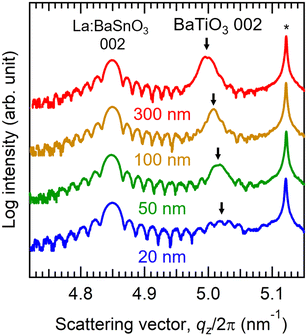 | ||
| Fig. 1 Out-of-plane XRD patterns of the BaTiO3 films with varied thickness grown on LBSO/STO substrates. The asterisk indicates the (002) STO substrate peak. | ||
Fig. 2 shows the reciprocal space mappings (RSMs) around the (103) diffraction spot for the BaTiO3 film with varied thicknesses. In case of the LBSO layer, the in-plane a-axis length (4.08 Å) is shorter than the out-of-plane c-axis length (4.125 Å) owing to the compressive strain from the STO substrate. The (103) diffraction spot of BaTiO3 was observed as a single spot without splitting, indicating that the BaTiO3 layer had a tetragonal structure. With increasing tBTO, the diffraction spot of BaTiO3 shifts toward the higher qz/2π side. The a-axis lengths of the BaTiO3 films are in the range of 4.01–4.07 Å, which is shorter than that of the LBSO layer, whereas it is longer than that of bulk BaTiO3. These results confirmed the presence of tensile strain in the BaTiO3 films.
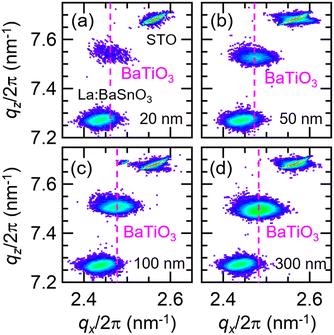 | ||
| Fig. 2 Reciprocal space mappings for the BaTiO3 film around the (103) diffraction spots. tBTO = (a) 20, (b) 50, (c) 100, and (d) 300 nm. | ||
Fig. 3(a) shows the lattice constants of the BaTiO3 films as a function of tBTO. Remarkably, the c-axis was shorter than the a-axis length, in contrast to the behavior observed for bulk BaTiO3. With increasing tBTO, the a (c) values of the films monotonically increased (decreased) and approached those of the bulk single crystal. Fig. 3(b) shows the tensile strain values of the BaTiO3 films. At tBTO = 20 nm, the tensile strain value is as high as 2.0%, which is much higher than the previous report on epitaxially grown BaTiO3 films on MgO substrate with the bottom electrode layer (<0.57%).19,20 The tensile strain value decreases with increasing tBTO and reaches 0.6% at tBTO = 300 nm. The decrease in the tensile strain with increasing tBTO was attributed to the relaxation of the in-plane lattice with increasing distance from the substrate because of the generation of dislocations in the film.28,29
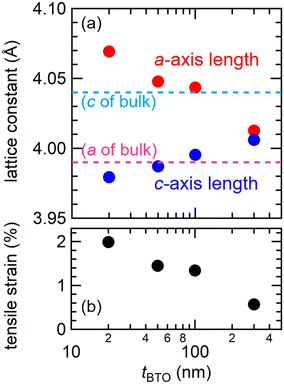 | ||
| Fig. 3 (a) Lattice constants and (b) tensile strain values for the BaTiO3 films as a function of tBTO. Figure (a) also includes the a- and c-axis lengths of bulk BaTiO3.8 | ||
The BaTiO3 films were deposited using PLD at a substrate temperature (Ts) of 850 °C and an oxygen partial pressure (PO2) of 0.5 Pa, with a laser energy of 0.5 J cm−2 pulse−1. Notably, PLD conditions are known to influence the lattice strain and properties of BaTiO3 films. For instance, the c/a values decrease with increasing Ts for BaTiO3 films grown on multilayer-buffered Si substrates.30 Additionally, it has been reported that oxygen vacancies are introduced at low PO2, while high PO2 results in locally incoherent grain boundaries in BaTiO3 films.31 Moreover, high laser energy has been shown to increase the growth-induced defect structures and create defect dipoles in BaTiO3 films.9 Hence, in this study, the influence of lattice strain due to defects induced by PLD conditions may affect the properties alongside the effects of strain provided by the substrate.
Fig. 4(a) illustrates the temperature (T) dependence of the out-of-plane XRD patterns of the BaTiO3 film with tBTO of 300 nm. To facilitate an understanding of the temperature-dependent changes in the BaTiO3 peak position, the horizontal axis is normalized by the SrTiO3 peak position, where 2θSTO and 2θBTO represent the 2θ values of the SrTiO3 (002) and BaTiO3 (002) diffraction peaks, respectively. The XRD equipment used for temperature dependence differs from that used at room temperature (refer to Fig. 1–3, see experimental section). For tBTO = 100 and 300 nm, the curves of 2θBTO – 2θSTOversus T exhibit kinks at ∼500 and ∼400 °C, respectively (Fig. 4(b)). Since bulk SrTiO3 is known not to undergo phase transitions in its crystal structure, the observed kinks are attributed to changes in the lattice constants of the BaTiO3 films. Such a change in lattice constants has also been observed in bulk and film BaTiO3 owing to a transition from the ferroelectric tetragonal phase (P4mm) to the paraelectric cubic phase (Pm3m).8 Thus, the observed kinks in the films with tBTO = 100 and 300 nm were derived from ferroelectric-to-paraelectric phase transitions. Choi et al. predicted the TC values of BaTiO3 film under biaxial in-plane strain based on thermodynamic analysis;8 the predicted TC was in the ranges of 300–500 °C and 400–800 °C when 0.6 and 1.3%-tensile strains were applied to the BaTiO3 film, respectively. These predicted TC values are consistent with our results: TC for the tBTO = 100 and 300 nm films with a tensile strain of 0.6 and 1.3% were ∼400 and ∼500 °C, respectively. On the other hand, no obvious kinks were observed in the 2θBTO – 2θSTO values versus T curves for the BaTiO3 films with tBTO = 20 and 50 nm below 600 °C.
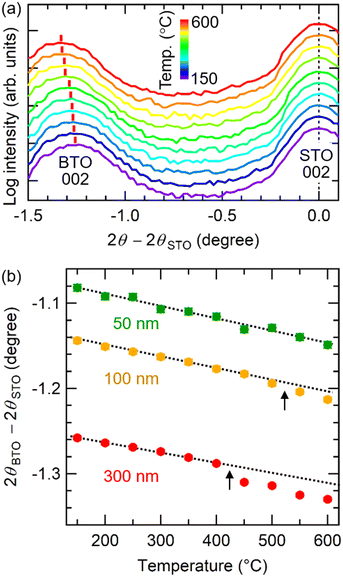 | ||
| Fig. 4 (a) Temperature dependence of the out-of-plane XRD patterns for the BaTiO3 film with tBTO = 300 nm. (b) The 2θBTO – 2θSTO values as a function of T for the BaTiO3 films with varied thickness. | ||
Fig. 5 shows the polarization versus electric field (P–E) curve for BaTiO3 films with tBTO = 20, 50, 100, and 300 nm. The measurements were conducted at 25 °C and a frequency of 10 kHz. At tBTO = 20 nm and 50 nm, no ferroelectric hysteresis loops were observed in the out-of-plane direction. This is probably because the ferroelectric polarization was completely along the in-plane direction, as observed in a previously reported BaTiO3 film under tensile strain.12,17 It is noted that bulk BaTiO3 with a perovskite structure exhibits tetragonal, orthorhombic, and rhombohedral symmetries below the ferroelectric transition temperature. While the polarization of the tetragonal phase aligns along the c-axis, that of the orthorhombic and rhombohedral phases align along the [110] and [111] directions, respectively.32 The direction of polarization is primarily determined by the availability of spatial regions where Ti ions can undergo displacement. For instance, in tetragonal BaTiO3 with c > a, there is spatial freedom for Ti ions along the c-axis direction, leading to spontaneous polarization along the c-axis. In our case, the BaTiO3 film exhibits a tetragonal structure (a = b ≠ c) with the a-axis length longer than the c-axis length. Consequently, the location of the spatial region available for Ti ion displacement differs from that of the bulk material, resulting in a change in the polarization direction.
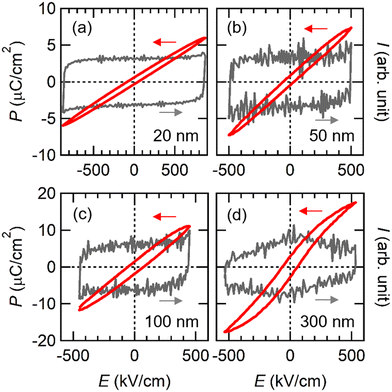 | ||
| Fig. 5 P–E and I–E curves of the BaTiO3 films with thickness of (a) 20, (b) 50, (c) 100, and (d) 300 nm. | ||
In contrast, at tBTO = 300 nm, a ferroelectric hysteresis loop was observed, accompanied by polarization-switching current peaks. The Pr value in the out-of-plane direction was 3 μC cm−2. This suggests that the ferroelectric polarization direction was slightly tilted away from the in-plane direction at tBTO = 300 nm because of the weaker tensile strain (0.6%) compared to other films (1.3–2%).
4. Conclusions
To achieve high tensile strain on the BaTiO3 film with the bottom electrode, we fabricated BaTiO3 films on a LBSO bottom electrode. The tensile strain values increase from 0.6 to 2% with decreasing thickness from 300 to 20 nm. The TC values of the 0.6 and 1.3%-tensile strained films are ∼400 and ∼500 °C, respectively, which are much higher than those of the bulk (120 °C) and previously reported tensile-strained films (220–220 °C). For the 1.4–2% tensile-strained sheet, the ferroelectric hysteresis loops were not observed in the out-of-plane direction, probably because the ferroelectric polarization aligns in the in-plane direction owing to the tensile strain. On the contrary, the 0.6%-tensile strained film displayed ferroelectric behavior along the out-of-plane direction, suggesting that the ferroelectric polarization direction was slightly tilted away from the in-plane direction.Conflicts of interest
The authors declare no competing financial interest.Acknowledgements
This work was supported by JST, PRESTO Grant Number JPMJPR21Q3, Japan, JSPS KAKENHI (20H02614 (TK)), and the Kao Foundation for Arts and Sciences (T.K.). H.O. was supported by a Grant-in-Aid for Scientific Research on Innovative Areas (19H05791) from JSPS. L.G. was supported by China Scholarships Council 202008050264.References
- F. A. Ismail, R. A. M. Osman and M. S. Idris, Review on dielectric properties of rare earth doped barium titanate, AIP Conf. Proc., 2016, 1756 Search PubMed.
- G. H. Haertling, Ferroelectric ceramics: history and technology, J. Am. Ceram. Soc., 1999, 82, 797–818 CrossRef CAS.
- S.-H. Yoon, M.-Y. Kim, C.-H. Nam, J.-W. Seo, S.-K. Wi and K.-H. Hur, Grain-growth effect on dielectric nonlinearity of BaTiO3-based multi-layer ceramic capacitors, Appl. Phys. Lett., 2015, 107, 072906 CrossRef.
- A. Feteira, D. C. Sinclair, I. M. Reaney, Y. Somiya and M. T. Lanagan, BaTiO3-based ceramics for tunable microwave applications, J. Am. Ceram. Soc., 2004, 87, 1082–1087 CrossRef CAS.
- Y.-F. Zhu, L. Zhang, T. Natsuki, Y.-Q. Fu and Q.-Q. Ni, Facile synthesis of BaTiO3 nanotubes and their microwave absorption properties, ACS Appl. Mater. Interfaces, 2012, 4(4), 2101–2106 CrossRef CAS PubMed.
- M. Acosta, N. Novak, V. Rojas, S. Patel, R. Vaish, J. Koruza, G. A. Rossetti and J. Rödel, BaTiO3-based piezoelectrics: Fundamentals, current status, and perspectives, Appl. Phys. Rev., 2017, 4(4), 041305 Search PubMed.
- M. P. McNeal, S.-J. Jang and R. E. Newnham, The effect of grain and particle size on the microwave properties of barium titanate (BaTiO3), J. Appl. Phys., 1998, 83, 3288–3297 CrossRef CAS.
- K. J. Choi, M. Biegalski, Y. Li, A. Sharan, J. Schubert, R. Uecker, P. Reiche, Y. Chen, X. Pan and V. Gopalan, Enhancement of ferroelectricity in strained BaTiO3 thin films, Science, 2004, 306, 1005–1009 CrossRef CAS PubMed.
- A. R. Damodaran, E. Breckenfeld, Z. Chen, S. Lee and L. W. Martin, Enhancement of Ferroelectric Curie Temperature in BaTiO3 Films via Strain-Induced Defect Dipole Alignment, Adv. Mater., 2014, 26, 6341–6347 CrossRef CAS PubMed.
- R. Guo, L. Shen, H. Wang, Z. Lim, W. Lu, P. Yang, Ariando, A. Gruverman, T. Venkatesan, Y. P. Feng and J. Chen, Tailoring Self-Polarization of BaTiO3 Thin Films by Interface Engineering and Flexoelectric Effect, Adv. Mater. Interfaces, 2016, 3, 1600737 CrossRef.
- O. Trithaveesak, J. Schubert and C. Buchal, Ferroelectric properties of epitaxial BaTiO3 thin films and heterostructures on different substrates, J. Appl. Phys., 2005, 98, 114101 CrossRef.
- D. G. Schlom, L.-Q. Chen, C.-B. Eom, K. M. Rabe, S. K. Streiffer and J.-M. Triscone, Strain tuning of ferroelectric thin films, Annu. Rev. Mater. Res., 2007, 37, 589–626 CrossRef CAS.
- L. Beckers, J. Schubert, W. Zander, J. Ziesmann, A. Eckau, P. Leinenbach and C. Buchal, Structural and optical characterization of epitaxial waveguiding BaTiO3 thin films on MgO, J. Appl. Phys., 1998, 83, 3305–3310 CrossRef CAS.
- I. Misirlioglu, S. Alpay, F. He and B. Wells, Stress induced monoclinic phase in epitaxial BaTiO3 on MgO, J. Appl. Phys., 2006, 99, 104103 CrossRef.
- C. Buchal, L. Beckers, A. Eckau, J. Schubert and W. Zander, Epitaxial BaTiO3 thin films on MgO, Mater. Sci. Eng., B, 1998, 56, 234–238 CrossRef.
- C. Lei, The growth of BaTiO3 films on (001) MgAl2O4 substrates by pulsed laser deposition technique, Thin Solid Films, 2006, 515, 1701–1707 CrossRef CAS.
- K. Komatsu, I. Suzuki, T. Aoki, Y. Hamasaki, S. Yasui, M. Itoh and T. Taniyama, In-plane ferroelectricity and enhanced Curie temperature in perovskite BaTiO3 epitaxial thin films, Appl. Phys. Lett., 2020, 117, 072902 CrossRef CAS.
- S. Kumar, D. Kumar, V. Sathe, R. Kumar and T. Sharma, Absence of low temperature phase transitions and enhancement of ferroelectric transition temperature in highly strained BaTiO3 epitaxial films grown on MgO Substrates, J. Appl. Phys., 2015, 117, 134103 CrossRef.
- F. He and B. O. Wells, Lattice strain in epitaxial BaTiO3 thin films, Appl. Phys. Lett., 2006, 88, 152908 CrossRef.
- W. Zhang, L. Kang, M. Yuan, Q. Yang and J. Ouyang, Effect of bottom electrode on the microstructure and electrical properties of sputtered BaTiO3 films on MgO substrates, J. Alloys Compd., 2013, 580, 363–368 CrossRef CAS.
- Q. Liu, J. Dai, Y. Zhang, H. Li, B. Li, Z. Liu and W. Wang, High electrical conductivity in oxygen deficient BaSnO3 films, J. Alloys Compd., 2016, 655, 389–394 CrossRef CAS.
- H. J. Cho, B. Feng, T. Onozato, M. Wei, A. V. Sanchela, Y. Ikuhara and H. Ohta, Investigation of electrical and thermal transport property reductions in La-doped BaSnO3 films, Phys. Rev. Mater., 2019, 3, 094601 CrossRef CAS.
- A. Prakash, P. Xu, A. Faghaninia, S. Shukla, J. W. Ager III, C. S. Lo and B. Jalan, Wide bandgap BaSnO3 films with room temperature conductivity exceeding 104 S cm−1, Nat. Commun., 2017, 8, 15167 CrossRef CAS PubMed.
- A. V. Sanchela, M. Wei, H. Zensyo, B. Feng, J. Lee, G. Kim, H. Jeen, Y. Ikuhara and H. Ohta, Large thickness dependence of the carrier mobility in a transparent oxide semiconductor, La-doped BaSnO3, Appl. Phys. Lett., 2018, 112, 232102 CrossRef.
- H. J. Cho, T. Onozato, M. Wei, A. Sanchela and H. Ohta, Effects of vacuum annealing on the electron mobility of epitaxial La-doped BaSnO3 films, APL Mater., 2019, 7, 022507 CrossRef.
- A. V. Sanchela, M. Wei, J. Lee, G. Kim, H. Jeen, B. Feng, Y. Ikuhara, H. J. Cho and H. Ohta, Buffer layer-less fabrication of a high-mobility transparent oxide semiconductor, La-doped BaSnO3, J. Mater. Chem. C, 2019, 7, 5797–5802 RSC.
- L. Gong, R. Yu, H. Ohta and T. Katayama, Synthesis and transparent conductivity of crack-free La: BaSnO3 epitaxial flexible sheets, Dalton Trans., 2023, 52, 6317–6323 RSC.
- H. Sun, W. Tian, X. Pan, J. H. Haeni and D. G. Schlom, Evolution of dislocation arrays in epitaxial BaTiO3 thin films grown on (100) SrTiO3, Appl. Phys. Lett., 2004, 84, 3298–3300 CrossRef CAS.
- T. Suzuki, Y. Nishi and M. Fujimoto, Analysis of misfit relaxation in heteroepitaxial BaTiO3 thin films, Philos. Mag. A, 1999, 79, 2461–2483 CAS.
- J. Lyu, I. Fina, R. Solanas, J. Fontcuberta and F. Sanchez, Tailoring Lattice Strain and Ferroelectric Polarization of Epitaxial BaTiO3 Thin Films on Si(001), Sci. Rep., 2018, 8, 495 CrossRef PubMed.
- J. Lyu, S. Estandia, J. Gazquez, F. M. Chisholm, I. Fina, N. Dix, J. Fontcuberta and F. Sanchez, Control of Polar Orientation and Lattice Strain in Epitaxial BaTiO3 Films on Silicon, ACS Appl. Mater. Interfaces, 2018, 10, 25529–25535 CrossRef CAS PubMed.
- J. Fujioka, A. Doi, D. Okuyama, D. Morikawa, T. Arima, K. N. Okada, Y. Kaneko, T. Fukuda, H. Uchiyama, D. Ishikawa, A. Q. R. Baron, K. Kato, M. Takata and Y. Tokura, Ferroelectric-like metallic state in electron doped BaTiO3, Sci. Rep., 2015, 5, 13207 CrossRef CAS PubMed.
Footnote |
| † Electronic supplementary information (ESI) available: See ESI for the details of AFM images of the BaTiO3 films. See DOI: https://doi.org/10.1039/d4ce00197d |
| This journal is © The Royal Society of Chemistry 2024 |
